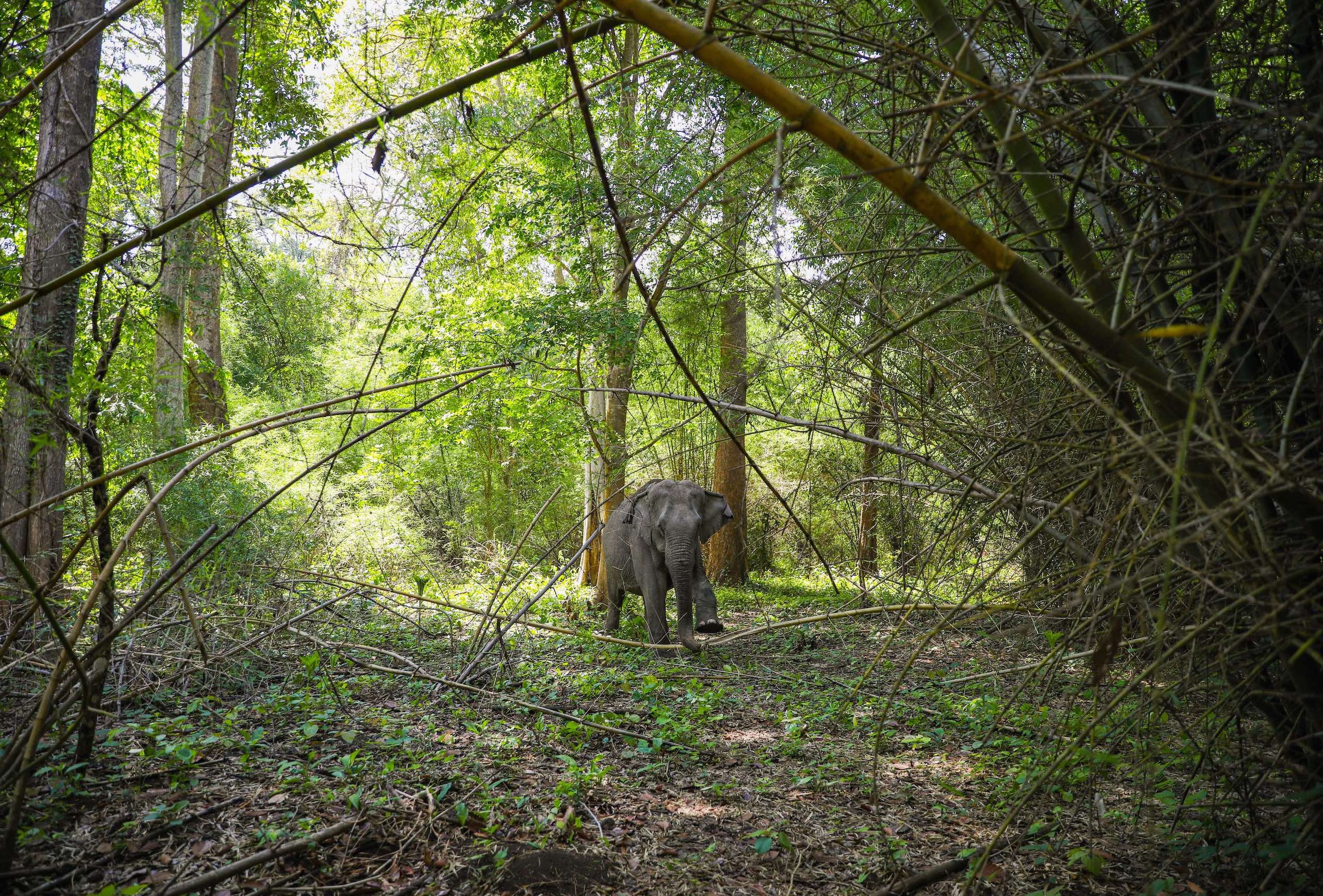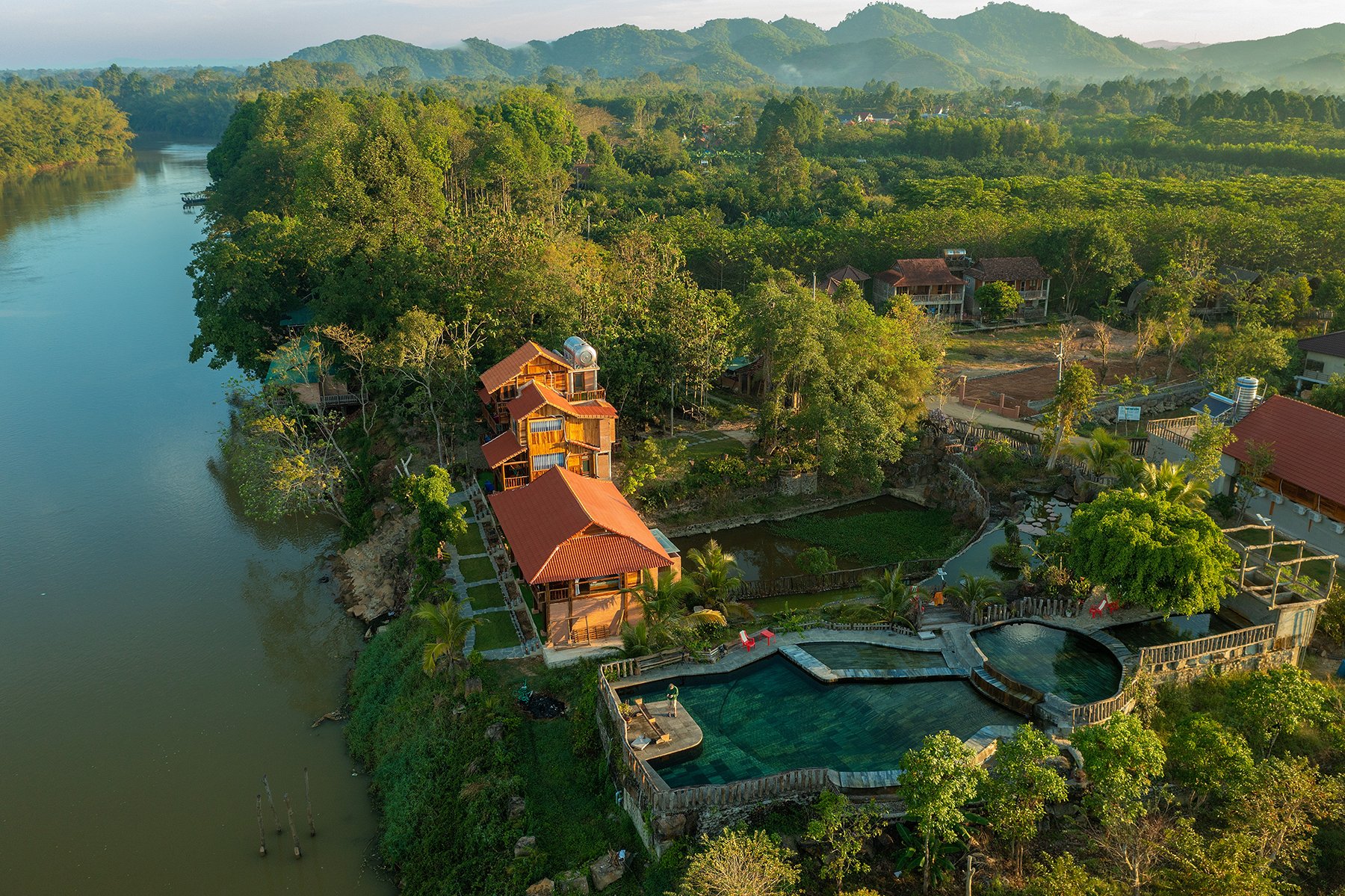Cat Tien National Park, Vietnam
OVERVIEW
With its sprawling forests and meandering rivers, Cat Tien National Park, Vietnam is a natural wonderland that beckons both adventurers and conservationists alike. Among its inhabitants are iconic species threatened with extinction, like the Asian elephant. A symbol of strength and wisdom, its presence in these ancient forests is a testament to the ecological value of this region.
This fragile paradise is where Vietnam’s last Javan rhino was killed by poachers in 2010, and it continues to face unprecedented threats from human activities and environmental degradation.
SIZE
170,000 Hectares
GOAL
$400,000
VISITORS BY 2030
42,000
Introduction
In 2010, Vietnam’s last rhinoceros was killed by poachers in Cat Tien National Park, marking a grim milestone as the country’s forests continue to be stripped of wildlife. Today, the country's tigers are extinct, sun bears are caged for bile farming, and only about 20 elephants remain in Cat Tien National Park, part of an estimated 100 wild elephants left in Vietnam. These elephants, the last vestiges of Asia's once 100,000-strong population, face numerous threats, particularly from human conflict driven by habitat loss.
Global Conservation has launched a four-year project to deploy Global Park Defense in Cat Tien National Park, aiming to expand protection to over 100,000 acres of adjacent unprotected forests and wildlife habitat.
A Fraught History
The Vietnam War (1955-1975) had a devastating impact on Vietnam's forests and wildlife. The US military used defoliants and bombs to destroy forests that concealed North Vietnamese troops and to subdue dense jungles. They sprayed more than 91 million liters of herbicides like Agent Orange, destroying about 7,700 square miles of forests (six percent of Vietnam's land area). Many of the forests destroyed during and after the war have never grown back, instead being replaced by grassland and bamboo thickets.
Natural Heritage
Cat Tien National Park’s vast expense of lowland tropical forest is one of the largest left in Vietnam. The park also includes tracts of seasonally flooded grassland and swamp forest, altogether a rich tapestry of biodiversity. Around 30% of Vietnam’s animal species live here, including 40 IUCN Red Listed species like the critically endangered Sunda pangolin and Siamese crocodile. The park is also home to more than 1,700 plant species.
Cat Tien National Park, part of the Dong Nai Biosphere Reserve, protects one of the largest remaining expanses of lowland tropical forest left in Vietnam.
Threats to Cat Tien National Park
Despite significant progress, Cat Tien’s wildlife remains at risk from habitat destruction and poaching. Enforcing wildlife protection laws and developing sustainable livelihoods for communities are critical to reversing this decline.
Illegal logging is one of the most pervasive threats to Cat Tien, stripping the forest of its ancient trees and depriving the ecosystem of vital resources. It not only destroys critical wildlife habitat but also leads to soil erosion and disrupts the water cycle, affecting the entire forest’s ecology.
Human encroachment, including expansion of agricultural land, infrastructure development, and human settlements, also fragments and destroys natural habitats. Habitat fragmentation confines wildlife to smaller areas and isolates populations, making it difficult for species to find food, mates, and other resources. This has long-term consequences on biodiversity and ecosystem health.
Cat Tien also faces challenges from forest fires, often caused by human activity, and climate change impacts such as altered precipitation patterns and rising temperatures, which further threaten the park's delicate ecosystems. Climate change exacerbates existing threats, affecting the availability of water and food sources and making survival even more challenging for wildlife.
The Javan Rhino in Vietnam is now extinct. Many other important species of this area are currently on the path of the rhino's fate.
The park is home to several endangered species, including the Asian small-clawed otter, Asian elephants, Chinese and Sunda pangolins, Siamese crocodiles, black gibbons, and the now functionally extinct Indochinese tigers. This makes the park a prime target for poachers. Wildlife poaching not only threatens individual species but also disrupts the intricate web of life within the park. Poaching significantly reduces population sizes, making recovery harder for species.
Elephants, for instance, are targeted for their ivory, while other animals are hunted for traditional medicine or the illegal pet trade.
Cat Tien’s Elephants
Elephants in Vietnam are critically endangered, with populations fragmented and declining due to habitat destruction and poaching. Vietnam's wild elephant population, which numbered around 2,000 in 1980, has plummeted to between 91 and 129 by 2022. The largest groups reside in Cat Tien, Pu Mat, and Yok Don National Parks, with the rest scattered thinly across nine provinces.
The conflict between elephants and humans, exacerbated by habitat loss and agricultural expansion, poses a significant threat to their survival. Recent incidents in Pu Mat National Park highlight the ongoing dangers, with elephants allegedly poisoned in retaliation for crop raids.
Vietnam's wild elephant population, which numbered around 2,000 in 1980, has plummeted. Cat Tien contains one of the country’s largest remaining populations.
Saving Cat Tien
Tackling these challenges requires a multifaceted approach, integrating scientific research, conservation management, and community engagement. Save Vietnam’s Wildlife (SVW) is actively working in Cat Tien National Park, organizing workshops with rangers and local communities to improve forest protection and wildlife conservation. This includes systematic snare removal, technology-enhanced patrols, and community-based conservation strategies. Additionally, efforts are underway to diversify tourism and generate sustainable income for local communities, reducing pressure on natural resources.
These efforts have led to valuable discussions on enhancing law enforcement and community awareness. SVW has also recognized and supported forest rangers injured in the line of duty, boosting morale and commitment to conservation efforts.
Rangers word around-the-clock to stop poaching efforts, which often involves removing snares found throughout protected natural ecosystems.
Efforts to combat illegal logging involve constant vigilance and enforcement, yet the challenge remains daunting due to the high demand for valuable timber and the vast expanse of the park. Promoting sustainable land use practices and involving local communities in conservation efforts are crucial steps towards mitigating habitat destruction.
Combating poaching requires coordinated efforts, including anti-poaching patrols and education initiatives to reduce demand for illegal wildlife products. Every day, park rangers patrol the vast expanse of Cat Tien, safeguarding its precious wildlife. Their vigilance helps prevent illegal activities like logging and poaching. Beyond protection, these rangers engage with local communities, fostering conservation awareness and promoting sustainable practices to ensure a harmonious coexistence with nature.
Key to its preservation are partnerships between the park, renowned conservation organizations, and governmental agencies. Cat Tien National Park stands as a bastion of biodiversity in Vietnam. But preserving this natural wonder also means fostering sustainable development for the local communities that depend on it. Sustainable development begins with empowering local communities. Projects focused on education and skill development help residents gain the knowledge and tools they need to build sustainable livelihoods.
Eco-tourism is a vital component of these efforts. It attracts visitors from around the world, providing economic opportunities while promoting environmental stewardship. Balancing conservation goals with sustainable socio-economic development is crucial for the future of Cat Tien National Park. Empowering local communities, promoting eco-tourism, and offering alternative livelihoods are key strategies in achieving this balance.
Our team works tirelessly to rescue, rehabilitate, and release wildlife that has been injured, orphaned, or threatened by human activity. Each successful release strengthens the park's biodiversity.
Combatting poaching is a critical aspect of conservation in Cat Tien. Thanks to intensified patrols and advanced technology, the park has made significant strides in reducing wildlife crime. Our anti-poaching units, equipped with the latest surveillance technology, have successfully disrupted poaching networks and saved countless animals from cruel fates. Each snare removed, each arrest made, represents a victory for wildlife conservation. These operations have not only protected endangered species but also restored hope for their future.
Our Objectives:
Secure a stronghold for globally threatened species through countering wildlife trafficking through enforcement, and creating scalable conservation models for Vietnam.
Reduce consumer demand for illegal wildlife products through an experiential mobile education center, “Vietnam says no to consuming illegal wildlife products”.
Deploy Global Park Defense, a multi-year method to achieve “No Cut, No Kill” protection and financial sustainability for continued preservation.
Work with local communities and local stakeholders to deploy Community Protection.
Critical Initiatives
SMART Ranger Patrols
Our partners are providing wildlife anti-poaching training, equipment, rations and technical support to Cat Tien National Park rangers to implement SMART patrols and the use of EarthRanger, increasing coverage, accountability and interdictions of illegal activities.
Establish a Community Forest Guard Program
To promote community engagement in conservation efforts and increase the effectiveness of anti-poaching efforts, our partners are developing a training program and recruiting local forest guards to conduct regular patrols. The guards will remove snares and engage with local communities to build trust and promote sustainable conservation efforts.
Establish a Biodiversity Baseline
One way to measure the success of our programs is through tracking wildlife populations through time. Our partners are using a camera trap survey to establish baseline wildlife populations in Cat Tien, which will then be repeated in order to track conservation success.
Conclusion
Cat Tien National Park is not just a sanctuary for wildlife; it is a vital part of our global ecosystem, providing essential services that benefit all of humanity. Now, more than ever, we need to come together to protect this natural heritage.
Vietnam's wildlife conservation story is one of resilience and hope. As government agencies, conservation organizations, and local communities unite, there is a growing awareness and commitment to protecting the country's unique biodiversity. Together, these efforts can ensure that the last elephants of Vietnam and other endangered species have a fighting chance to thrive once again.
Global Conservation initiatives rely on your generosity and commitment, please join us: your contributions fund essential operations like anti-poaching patrols, wildlife rehabilitation, and community outreach programs. Join us in this vital mission — act now to preserve Cat Tien National Park and make a lasting impact.
Partners in Conservation
Save Vietnam’s Wildlife (SVW) is a local organization established in Vietnam to carry out non-profit conservation activities for wildlife and ecosystem restoration purposes. Thai Van Nguyen founded Save Vietnam’s Wildlife (SVW) in 2014 to stop the hunting of critically endangered Chinese pangolins and Sunda pangolins, widely acknowledged to be the most trafficked mammals on earth. Thai also set up Vietnam’s Pangolin Conservation Action Plan, which is the first national strategy for species conservation. Thai believes that education plays a key role in convincing people of the inherent worth of the pangolin, so in 2017, SVW opened Vietnam’s first wildlife education centre that focuses on pangolins.
“Education plays a key role in convincing people of the inherent worth of the pangolin: it is unique as the earth’s only scale-covered mammal and an important regulator of insects and provider of burrow shelters to host other species. Education also empowers people to take informed choices: pangolin scales are not magical medicines.”
-Thai Van Nguyen

































